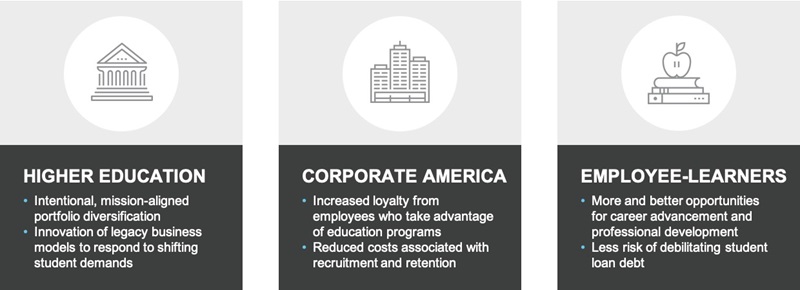In Brief
The Value Proposition of Joint Ventures in Employer-Supported Strategic Education
There is little that is substantively new about today’s challenges in higher education. The current environment, wherein institutions of higher learning are grappling with myriad disruptive external global forces (including the COVID-19 pandemic), has simply accelerated the timeline for many highly anticipated improvements and innovations to centuries-old business models. This moment in time underscores the necessity for colleges and universities to intelligently diversify (not just proliferate) their offerings as part of a broader strategy to become more resilient to future “shocks.”
Top-line revenue strategies focused on international enrollment, dynamic pricing and enrollment growth have run their course, and the proliferation of more traditional degree programs has proven to have limited scale. To identify new revenue streams and further develop the industry’s agility in the face of future external challenges, creative leaders are seeking entry into adjacent markets that support the mission of higher education but also promise flexibility and long-term growth.
The creation of employer-supported strategic education programs is one such avenue for progress. Industry leaders like Arizona State University, City University of New York School of Professional Studies, the University of Washington and the University of Wisconsin-Madison have been first movers in this space, partnering with the likes of Aramark, Adidas, Starbucks, Prime Communications and Uber to offer innovative programs that bridge the gap between employee skill sets and evolving employer needs.
As higher education continues to struggle with containing costs, high-tech companies like Amazon, Google and Facebook that experiment with novel methods for providing training and education to their employees are looming threats to traditional postsecondary institutions. To remain competitive, colleges and universities must lean in to develop a collaborative model that leverages both sectors’ unique strengths and resources so that corporations do not feel the need to recreate existing higher education delivery models.
Realizing Optimal Benefits for All Stakeholders
The old model of higher education’s engagement with employers, which focused primarily on philanthropy and research collaboration, is now shifting to create deeper points of connection between academia and corporate America via alumni relations, continuing education and career development, to name a few. Among these innovative new models, strategic partners are developing data-driven programs for working adults that are mutually beneficial for higher education, corporate America and employee-learners.
Higher Education Institutions Experiment With New Revenue Streams
Higher education’s interest in accessing this new market involves equal parts offense and defense. On one hand, employer-supported education programs are a natural, mission-aligned “product” extension of what higher education institutions have been doing for centuries. On the other, effective partnership models may also prevent the private sector from making significant investments to create training or educational offerings of their own that yield market value comparable to those of established universities.
Additionally, a growing number of institutions are realizing that in order to effectively recruit top students, they must deliver a different kind of value proposition that includes a clear connection between students’ education and their employability or professional development. Education programs create a line of sight into possible career pathways and promote retention through promised progression — an insight that can also be leveraged to shape curriculum and academic portfolios in the future. Partnering on innovative new programs with employers in competitive job markets provides universities another differentiating market position, in addition to a new revenue stream and willing collaborators with which to enhance academic offerings.
Education Programs Engender Loyalty, Retention and Engagement
Nearly 70% of workers report that they do not possess the skills required to do their jobs today. Yet, many corporations that experiment with offering educational programs voice the same concern — what if I spend precious resources to better educate and prepare my employees only to have them leave and use their new skills in another company?
The fact of the matter, though, is that these types of education programs engender increased company loyalty as well as employee retention and engagement. In other words, employees that benefit from the program fill the corporation’s management pipeline while also bringing new knowledge, innovation and skills to their current roles that deliver long-term contributions to the business. And while the most quantifiable metric associated with high turnover is the cost of recruitment, the returns on business continuity, culture development and institutional knowledge should not be undervalued. According to InStride, the dollars spent on Strategic Enterprise EducationTM return as much as two times the investment for its corporate partners.
Employee-Learners Benefit From Upskilling and Less Debt
Today’s students are better-informed consumers with increasing price sensitivity and an aversion to debt. Thus, pricing power in higher education is shifting to the “buyer,” along with a greater emphasis on transparency, outcomes, and shortand long-term returns. A company-supported degree appeals to both cost sensitivity and risk aversion. Students will graduate with less debt and will progress through their education with greater clarity about what awaits them after graduation.
Similarly, as the shelf life of today’s skills decreases and the number of previously unheard-of occupations increases (a 2020 report by Gartner predicts that 19% of skills will be irrelevant in three years), continuing education becomes more and more important for employees at all levels. Curricula tailored to a particular company, industry or function benefit the employer by developing employees’ skill sets, but it also makes students more marketable should they voluntarily or involuntarily (particularly salient considering the current unemployment rate) transition from the sponsoring company.
The proliferation of employer-supported strategic education programs is the next step on the maturity curve for higher education. The coming of age of corporate-university partnerships has been discussed for decades, its inevitability tied to a clearly articulated shared value proposition for universities, employers and employees. The COVID-19 pandemic did not create the undercurrents of the disruption playing out in higher education today, but it certainly is accelerating long-anticipated structural changes in the industry, particularly the scalable diversification of revenues and an intensified focus on quality and affordability.






